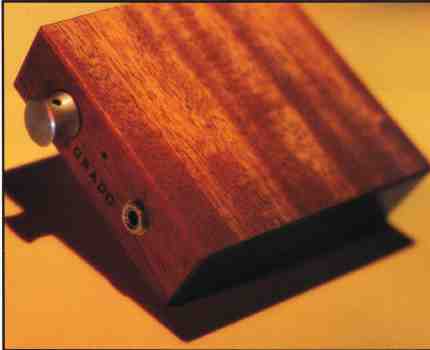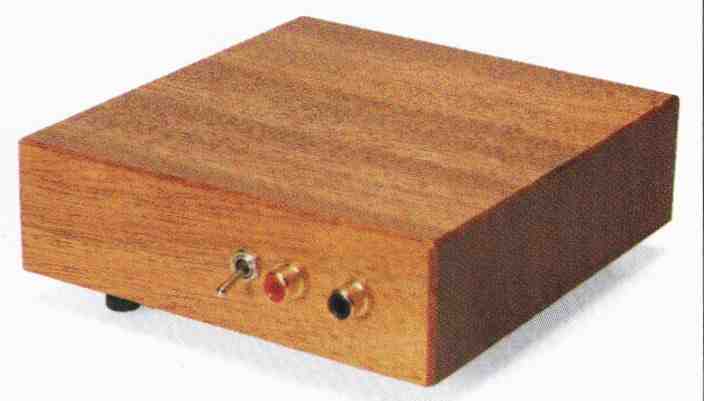|
|
= = =


GRADO RA-1 (specs)
Rated Frequency Range: 20 Hz to 20 kHz.
Rated Power Output: 250 milliwatts.
Rated Input Impedance: 100 kilohms.
Weight 1 lb. (0.4 kg).
Price: $350.
Company Address: 461 4 7th Ave., Brooklyn, N.Y. 11220.
= = =
I have a confession to make—one that, I’m sure, seal off the last remaining avenue to my quest for the highest elected office in the land. Back in the 1960s, I indulged in certain youthful transgressions: I listened to music through headphones.
In those times I never met a crossover I couldn’t melt. And when my very last speaker bit the dust, it was a pair of head phones, dynamically modest though they were, that saved the day. Headphones couldn’t rattle the kitchen cabinets like a pair of Altec’s Voice of the Theater industrial P.A. horns, but with a few candles and some good wine, who cared? The Beatles, The Stones, and The Moody Blues all man aged to make their presence felt.
Cassettes were brand-new in the late ‘60s; on the road or at home, 8-track was still the tape format of the masses. Mostly though, LPs ruled the roost, and back then many of the phono cartridges that played them were manufactured by Grado Labs, one of the oldest family-owned companies in the audio industry.
Grado! Rolls right off the tongue, no? Great name for a new shoe everyone’s talking about, as in, “Hey! My girlfriend got me a pair of Grados for my birthday.” Or a tasty new snack, as in, “Sweetheart, get me a beer and a bag of Grados and hand me the remote, will you?”
Brooklyn-born Joe Grado began producing phono cartridges at his kitchen table in 1953. In 1958, he opened a storefront factory on the Site of his Sicilian-born father’s fruit Store in Brooklyn’s Sunset Park, manufacturing his new invention, the world’s first moving-coil phono cartridge. In 1990, 32 years and 10 million cartridges later, John, Joe’s nephew, branched the company out into a new line of audiophile-grade headphones, to great success. Grado Labs’ entry-level SR60 headphones ($69) are probably hi-fi’s best headphone bargain. Meanwhile, Grado says it sold 60,000 phono cartridges last year, an incredible feat at this stage in the game.
So this brings us to the real business at hand—the dedicated headphone amplifier. High-end headphone manufacturers have always been frustrated by the paltry attention paid to the circuitry behind most amplifiers’ and receivers’ headphone jacks, and with good reason: The biggest amp manufacturers were not headphone manufacturers, so headphone sound quality was never a priority. Lots of components nowadays don’t even include a headphone jack. Users of high-quality headphones often find themselves staring at a $4,000 amplifier with no place to stick them in.
That’s when John Grado realized the dedicated headphone amp was a niche waiting to be filled. Other high-end head phone companies felt the same way, largely because of a world of headphone jacks that simply did not meet their standards. The original Grado Reference Products headphone amp was introduced in 1994 at $795; today the price has fallen to $350. I re viewed its current version, which represents the company’s latest thinking on how best to drive its special ‘phones.
The design is fairly simple: a pair of audiophile-grade op-amps with high-current output capability and wide bandwidth, a high-quality volume control, a single head phone output (beefy enough, Grado says, to drive two pairs of headphones at once), and a set of stereo RCA line inputs. The RA- 1 is housed in a cabinet hewn from a solid block of mahogany approximately the size of a stack of four CD cases (5½ x 5½ x 1½ inches). It weighs just 12 ounces and is powered by two 9-volt batteries that supply the amp with 40 to 50 hours of operating time. Grado’s modest press release describes the sound of the RA-1 amp in terms that would serve uncannily well in characterizing a tasty, late-harvest German Riesling: “warm, smooth, full-bodied, non-fatiguing, and rich.” Yum! I couldn’t wait to hook it up. Setup is simple: Insert two 9-volt batteries, connect the amp inputs to any high-level line source (portable or in-home), and away you go. You probably don’t want to be wearing your head phones when you turn the RA-1 amp on, though: When it clicks on, it produces a bright, audible pop. John Grado claims a great Sisyphean trade-off was required: Nix the pop, and sonic integrity falls off ever so slightly. Hence, the pop stays.
So, I thought I’d slip on my Grado Labs’ SR80 headphones ($95), plug ‘em into the Grado Reference PA- 1 amp, and go hunt me some bear. I headed right for some big ol’ super-dense orchestra music from Erich (the bad boy of turn-of-the-century Vienna) Wolfgang Korngold and, using an all NAD rig as my baseline, loaded up. I hooked the Grado amp into the “Rec Out” jack of the excellent, no-fuss NAD 317 integrated amp, mated to an NAD 512 CD player, and cued up the opening bars of Korngold’s brilliant, “unperformable” magnum opus, Das Wunder der Heliane (London 436636). A lush, celestial, chordal theme for full orchestra and harmonium wells up in a progression of shimmering, bi-tonal harmonies that crystallize the opera’s recurring themes of the power of eternal love and resurrection. Phew!
I greedily plugged the SR80s into the Grado RA-1 and began to listen to this fabulous music, planning to hear a few minutes worth and then begin switching between the RA-1 and the NAD. Forty minutes later, I realized I had been savoring this music in a way I never had before. The sound was at once more immediate, clearer, and more refined than I recalled from speaker listening. A quick switch over to the NAD provided my first confirmation of the rightness of dedicated headphone amps. The NAD’s sound was broader, more dif fuse, with voices less focused in the mid range and not nearly as dear and airy in the high end. The music heard through the Grado Reference RA-1 amp sounded appreciably better in every way.
Next, on to the splendid composer/arranger Maria Schneider’s distinguished, hard swinging, big-band jazz orchestra. On the edgy, fear-laced “Bombshelter Beast,” the first section of the three-movement “Scenes from Childhood” suite from her 1996 recording Coming About (Enja ENJ 90692), Scott Robinson’s gutsy baritone sax projected real heft for such a diminutive speaker system. And Jim Anderson’s uncannily concise mix of this authoritative 19-piece ensemble, complete with brilliantly involved theramin (again, Robinson’s) remained dynamically smooth throughout. Tony Scherr’s creepy, “bug-crawling-up-your-leg” deep electric bass lines on “Night Watchman” sent me cranking up the volume, fascinated by its better-than-lifelike presence through the Grado 5R80 head phones and RA-1 amp.
This kind of music is richly layered, engagingly plotted, and powerfully performed here. On sexier, laid-back cuts like “Love Theme from Spartacus,” I found an exquisitely audible midrange tension in Rich Perry’s tenor-sax playing that was not nearly as pulsingly vibrant when heard through the NAD’s jack.
While headphone listening can never approach the bone-crunching deep bass of full-size, high-end speakers with subwoofers or hope to project the high-grade imaging of full-blown systems, the benefits and ad vantages of the Grado 5R80 headphones— with the Grado Reference RA-1 amp doing the driving—were stunning in serving as a— sort of microscope for my ears.
This was a consideration made strikingly clear when I swapped the Kimber Hero cables connecting the RA-1 with a pair of generic, came-in-the-box cables I had lying around. Gadzooks, what a difference! The entire sound profile took on the lackluster patina of soiled tape heads. Dullsville.
Back to the cleaner, more detailed sound of the Kimbers, and back again to Korngold for my final test audition, a bit of his flawlessly detailed, yet orchestral-esque, chamber music. Korngold, after the strenuous effort of composing opera and large orchestral pieces, would seek a kind of psychic sabbatical in chamber pieces. Quite a few of these exciting works are now finally available on CD. In the kinetic first movement of his String Quartet No. 1 in A, Op. 16, with the Chilingirian Quartet (RCA Gold Seal 7889-2-RG), an extremely demanding piece to perform, Korngold brilliantly juxtaposes a forbidding, relentlessly onrushing, chromatic figure with a poignantly touching love theme in a way that in its sound picture is pure Korngold, at once displaying breathtaking technique and lovely tenderness. Here the Grado RA-1 really came through with flying colors, allowing a terrifically precise dynamic flow, more focused and with a far more accurate sense of presence than the NAD.
Overall, with no disrespect to the NAD 317, which is a first-class integrated amp and then some, the all-Grado listening experience with the SR80 headphones and RA-1 dedicated headphone amp was quite a turn-on. With the Grado Reference RA-1 handling the amplification, music was rendered truer, clearer, and more lifelike than I had imagined was possible. Hats off to Joseph and John Grado!